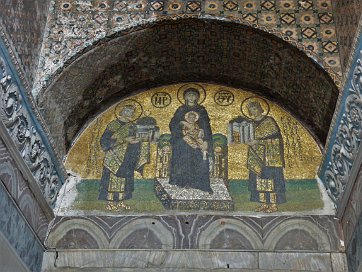This church was built by Emperor Theodosius in the 5th century. But this was not the first church to stand here. Theodosius’ church replaced an earlier…
At a a time when most churches were simple longitudinal structures (known as basilicas) covered by a wooden roof. The builders of Hagia Sophia introduced a…
After the conquest of Istanbul, after the Hagia Sophia church was converted into a mosque, The minaret in the southeast is the name of Fatih Sultan Mehmet…
This formidable building remained one of the largest churches throughout the next thousand years. In volume, it can be compared to the Cathedral of Amiens, the…
Ablution fountain (Şadırvan) was built in 1740 CE by Sultan Mahmud I over the site of a Byzantine Patriarchate, the fountain with its eight marble columns in…
Standing in front of the entrance to Hagia Sophia, we immediately notice the flying buttresses that conceal the west façade of the building. These structural…
This mosaic, dated to the 10th century, is located above the Emperor's Gate. The depiction of Jesus in the middle of the scene holds an open Bible in his left…
The Emperor's Gate or the Imperial Door is the door that would be used solely by the Emperor as well as his personal bodyguard and retinue.
Just above the…
Just above the…
The Emperor's Gate is the largest door in the Hagia Sophia and has been dated to the 6th century. It is about 7 meters long and Eastern Roman sources say it was…
The inner narthex has the walls are covered in marble panels all the way up to the springing level of the vaulted arched ceilings. As in most other Byzantine…
Each of the nine bays of the inner narthex has a door leading into the main body of the church. The doors were originally covered in bronze and decorated with…
Procopius’ impression of the dome: "Rising above this circle is an enormous spherical dome that makes the building exceptionally beautiful. It seems not to be…
Hagia Sophia’s more advanced structural system allowed for an interior that was not only much larger than the dome but also filled with light streaming from the…
The existing hanging chandeliers are an Islamic addition dating back to the Fossati brothers' renovations (1847-1849). A large chandelier surrounded by pendant…
